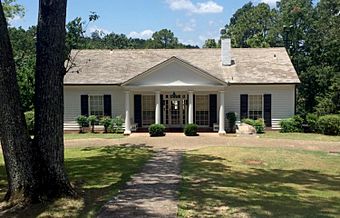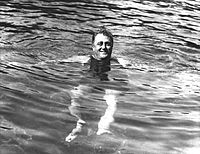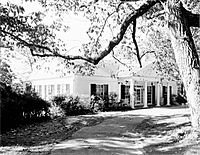Warm Springs Historic District facts for kids
|
Warm Springs Historic District
|
|
 |
|
| Location | S of GA 194 and W of GA 85W, Warm Springs, Georgia |
|---|---|
| Built | 1924 |
| Architect | Henry J. Toombs, Eric Gugler, et al. |
| Architectural style | Colonial Revival |
| NRHP reference No. | 74000694 |
Quick facts for kids Significant dates |
|
| Added to NRHP | July 30, 1974 |
| Designated NHLD | January 16, 1980 |
The Warm Springs Historic District is a special area in Warm Springs, Georgia. It is known for its history. This district includes the Little White House, which was the home of Franklin D. Roosevelt. He was a former President of the United States. The district also has the Roosevelt Warm Springs Institute for Rehabilitation. Roosevelt loved to use the warm springs there. Many buildings in the area were built in the 1920s and 1930s. The district still looks much like it did when Roosevelt visited often.
People have used these warm springs for a very long time. Even people from prehistoric times used them. Just like when Roosevelt used them, the water temperature was about 89 degrees Fahrenheit (32 degrees Celsius).
Contents
History of Warm Springs
In the late 1700s, people from Savannah, Georgia, started coming to Bullochville for vacations. They wanted to escape diseases like yellow fever. The warm springs nearby were a big attraction. Later, in the 1880s and 1890s, many wealthy people from Atlanta also came to vacation here. They traveled by train to Durand, then went to Bullochville. The Meriwether Inn was a popular place to stay. But when cars became common in the early 1900s, tourists started going to other places. This caused the Meriwether Inn to decline.
Franklin D. Roosevelt's Connection
Franklin Delano Roosevelt first visited Warm Springs in October 1924. He came to a resort that had an 88-degree natural spring. However, the main building, the Meriwether Inn, was quite old and run-down. In 1927, Roosevelt bought the resort and the 1,700-acre farm around it. Around this time, Bullochville was renamed Warm Springs.
Roosevelt visited the area many times. He came 16 times while he was the President of the United States. He passed away in the district on April 12, 1945. This happened at his Little White House, which he had built in 1932.
Founding the Institute
Roosevelt started the Institute after hearing about a boy. This boy had regained the use of his legs through a treatment called hydrotherapy. Hydrotherapy uses water to help with pain and treat illnesses. The Foundation for Infantile Paralysis paid for the Institute's work. This foundation later became known as the March of Dimes.
The Institute Today
Today, the place is called the Roosevelt Warm Springs Institute for Rehabilitation. It is a special facility run by the state of Georgia. It helps people recover from injuries and illnesses. It is a center for treating post-polio issues. It also helps people with job training, long-term care, and recovery from spinal cord injuries, brain damage, and strokes. It also helps people who have had amputations.
The original historic pools are usually not open to the public. But once a year, on Labor Day Weekend, the Little White House / DNR opens them. People can swim in the waters for an hour and a half in groups.
Georgia Hall
The main building of the Roosevelt Warm Springs Institute is Georgia Hall. It was built in 1933. It replaced the old Meriwether Inn, which was too old to fix up. Roosevelt often held Thanksgiving dinners in Georgia Hall's dining room. He invited those who were using the Springs for treatment. For a long time, this institute was the only place focused only on helping polio patients.
The Warm Springs Historic District was named a National Historic Landmark in 1980. This means it is a very important historical place.







